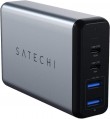USB A ports
The number of USB connectors in the design of the device. We emphasize that here we are talking only about classic, full-size connectors — the so-called USB A; the number of USB-C ports, if any, is specified separately (see below).
The number of USB ports (of any type) corresponds to the number of gadgets that can be simultaneously connected to the charger using adapter cables or plugs for the appropriate connector. Note that not all chargers are capable of delivering full power to all charging outputs at once; see "Charge current" for details. As for the specific number of ports (USB A and/or USB-C), nowadays, relatively simple chargers for
1 port or
2 ports are the most popular. This is due to the fact that separate chargers are usually purchased for one or two specific gadgets, and a larger number of charging outputs is required relatively rarely. However, on the market you can easily find models with
3 ports or
4 ports ; and the most “multi-charged” modern devices have
5 or
6 USB ports or even more.
USB-C ports
The number of
USB-C connectors provided in the design of the charger.
USB-C is a relatively new type of connector; it has dimensions slightly larger than microUSB and a double-sided design that allows you to insert the plug in either direction. At the same time, despite their compact size, rather advanced features can be implemented in such charging ports — in particular, high power supply and many fast charging technologies. On the other hand, specifically in chargers for gadgets, connectors of this type are much less common than full-sized USB (USB A), and in smaller quantities —
one at a time, less often
two. This is due to the fact that a cable is usually used to connect rechargeable gadgets, with detachable cables it is more convenient to use ordinary USB ports, and installing such ports in a charger (even a compact one) is easy. So in fact, it makes sense to specifically look for a device with USB-C mainly if the you have such a cable already (or a gadget with a suitable plug).
Fast charge
Fast charging technology supported by the device.
By itself, fast charging, as the name suggests, reduces the charging time compared to the standard procedure. For this, increased voltage and/or current power is used, as well as a special smart process control. But the possibilities and features of such charging may be different, depending on the specific technology used in the device. The same technology must be supported by the charger too — this is the only way to 100% guarantee correct operation. However some types of fast charging are mutually compatible — this point should be clarified separately, and compatibility is not always full.
Nowadays, the following technologies are most widely used: Quick Charge of different versions (
3.0,
4.0, 5.0),
Power Delivery (
version 3.0 and
3.1),
Pump Express,
Samsung Adaptive Fast Charging,
Huawei Fast Charge Protocol,
Huawei SuperCharge Protocol,
OPPO VOOC,
OnePlus Dash Charge. Here is a brief description of each of them:
— Quick Charge (1.0, 2.0, 3.0, 4.0, 5.0). Technology created by Qualcomm and used in gadgets with Qua
...lcomm CPUs. The later the version, the more perfect the technology: for example, Quick Charge 2.0 has 3 fixed voltage options, and version 3.0 has a smooth adjustment in the range from 3.6 to 20 V. Most often, gadgets with a newer version of Quick Charge are compatible with more old charging devices, but for full use, an exact match in versions is desirable.
Also note that certain versions of Quick Charge have become the basis for some other technologies. However, the mutual compatibility of chargers and gadgets with support for these technologies needs to be clarified separately.
— Pump Express. Own development of MediaTek, used in portable devices with CPUs of this brand. Also available in several versions, with improvements and additions as it develops.
— Power delivery. Native fast charging technology for the USB-C connector. Used by many brands, found mainly in chargers and gadgets equipped with this type of connector. Presented in several versions.
— Samsung Adaptive Fast Charging. Samsung's proprietary fast charging technology. It has been used without any changes since 2015, so it looks rather modest compared to newer standards. Nevertheless, it is able to provide good speed, especially in the first 50% of the charge.
— Huawei FastCharge Protocol. One of Huawei's proprietary technologies. Formally similar to Quick Charge 2.0, but used with both Qualcomm and other brands of mobile CPUs, so compatibility is not guaranteed. In general, it is considered obsolete, gradually being replaced by more advanced standards like the SuperCharge Protocol.
— Huawei SuperCharge Protocol. Another proprietary technology from Huawei introduced in 2016; for 2021 is available in several versions. In some devices, the power of such charging exceeds 60 V — not a record, but a very solid indicator.
— Oppo VOOC. OPPO technology, used both in branded smartphones and in products from other brands. Available in several versions; The latest (for 2021) version of SuperVOOC is for 2-cell batteries and is sometimes listed as a separate technology called Oppo SuperVOOC Flash Charge.
— OnePlus Dash Charge. A relatively old proprietary standard from OnePlus. An interesting feature is that in some gadgets, the effectiveness of Dash Charge is practically independent of the use of the screen: when the display is on, the battery charges at almost the same rate as when it is off. Technically a licensed version of OPPO's VOOC, however, these technologies are not compatible. Since 2018, Dash Charge has been phased out by Warp Charge, but this newer technology is rarely used in separately sold chargers.
In addition, on the market you can find chargers that support rarer and more specific formats of work; the features of these formats can be clarified by special sources. 
